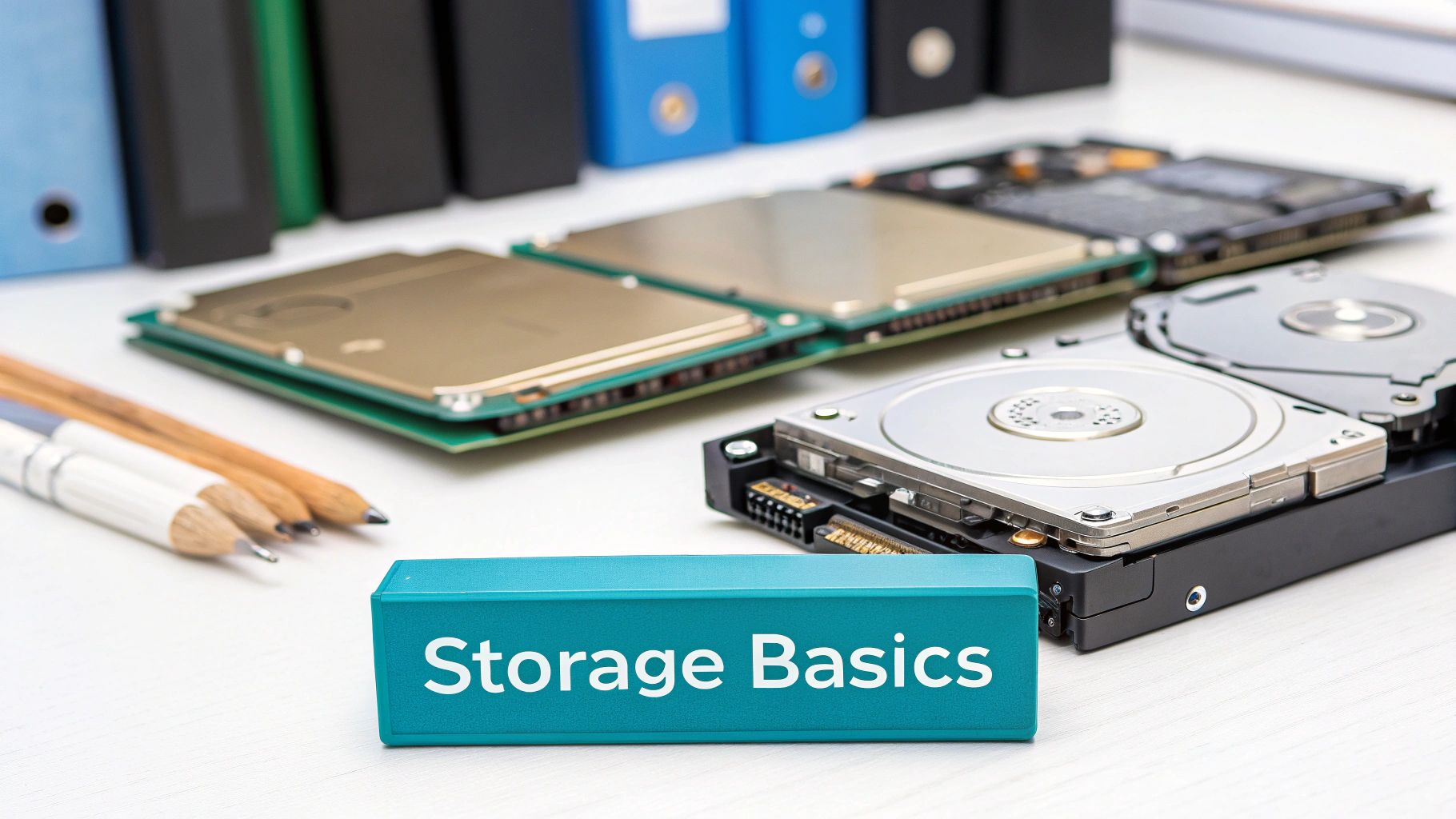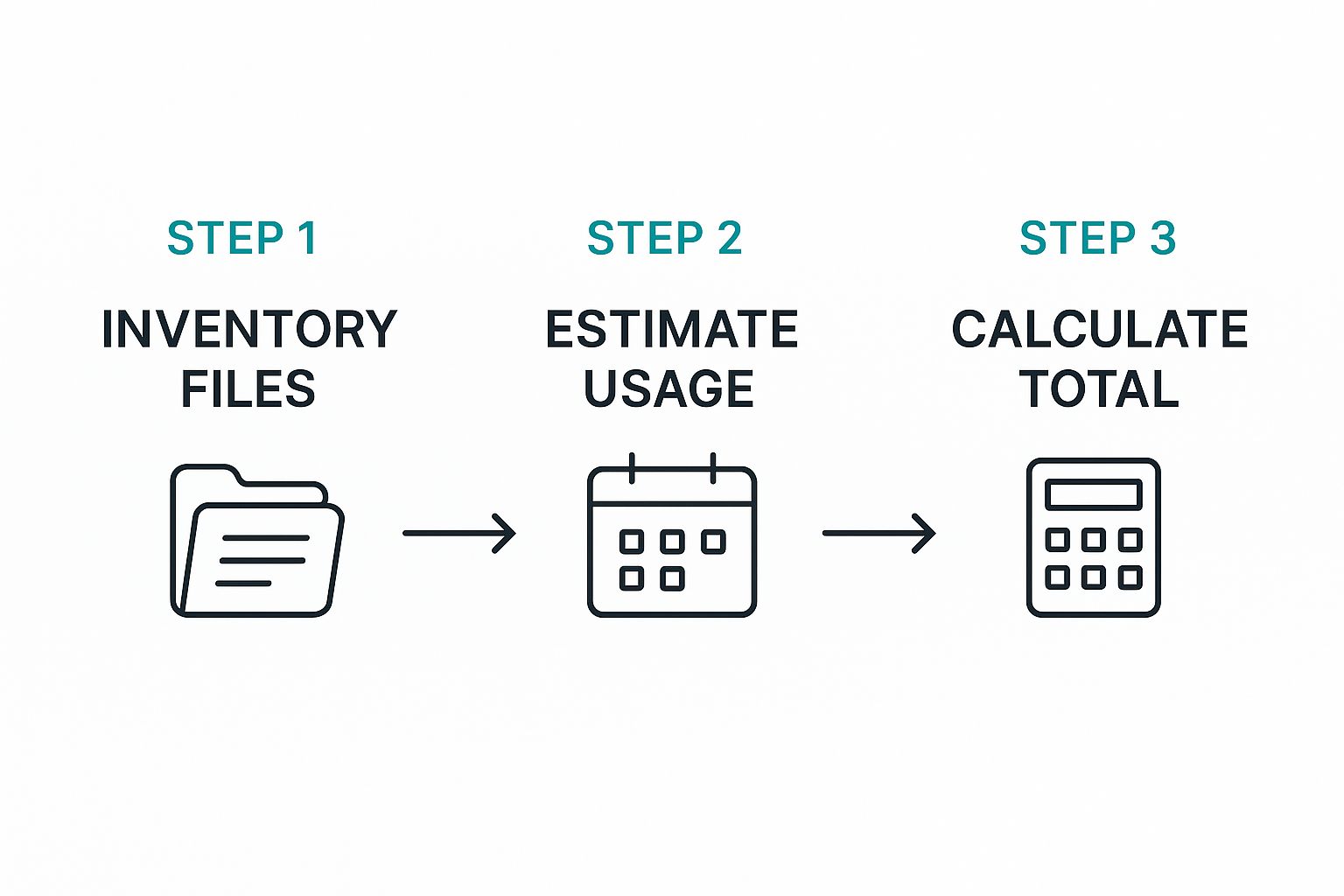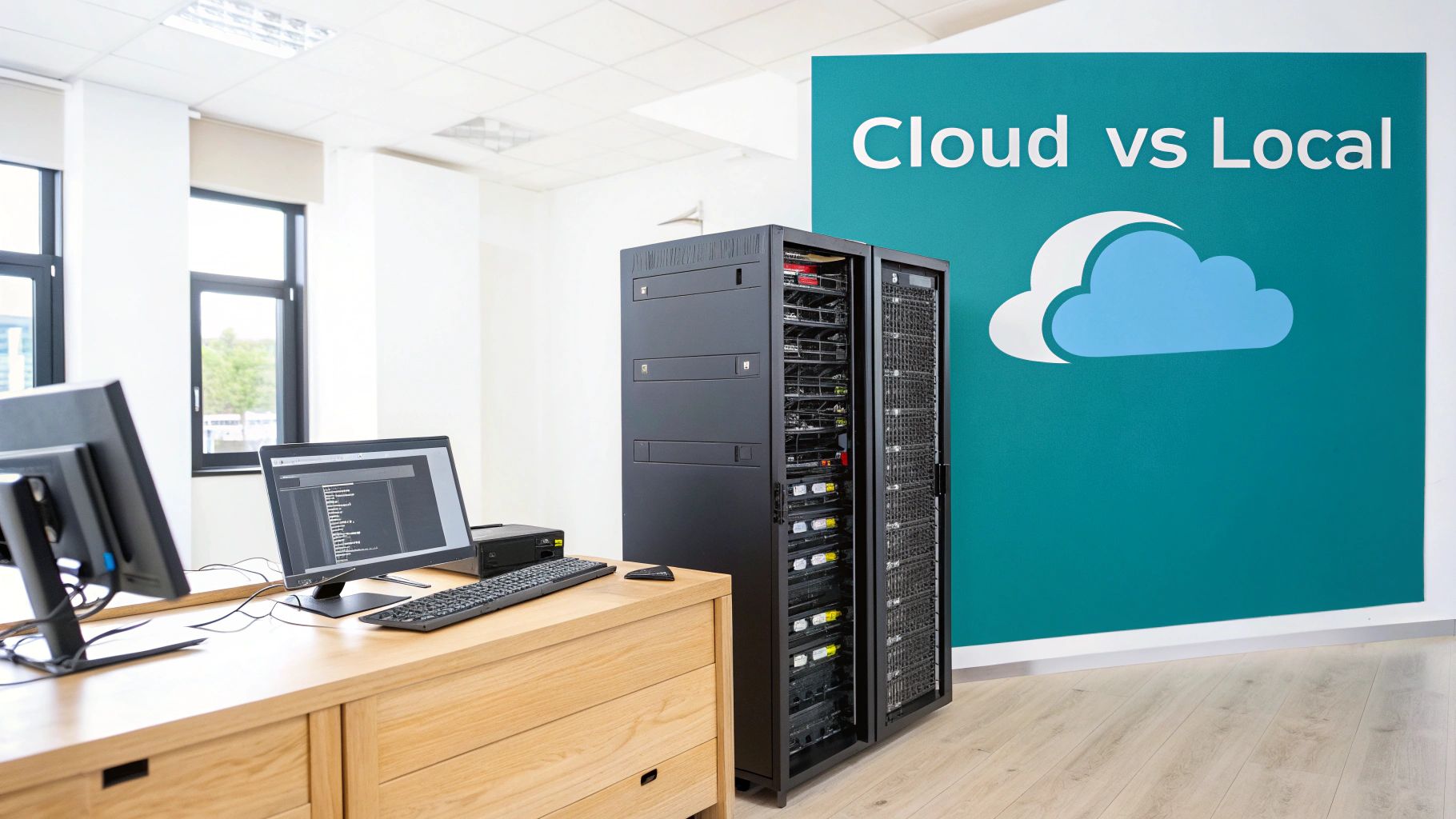Figuring out exactly how much storage you really need can feel like a guessing game. As a rule of thumb, we find the contents of a typical one-bedroom flat usually fit comfortably into a 50 sq ft storage unit. For the digital side of things, most people get by just fine with 200GB to 1TB of cloud storage.
Finding Your Storage Starting Point

The question "how much storage do I actually need?" is one we all face sooner or later. Maybe you're trying to reclaim a spare room, moving house, or you're just sick of seeing that 'Storage Full' alert pop up on your phone again.
There’s no magic number here. The right amount of storage depends entirely on your situation and what, precisely, you need to tuck away.
Before you start measuring furniture or counting files, it helps to separate your 'stuff' into two piles: physical belongings and digital files. Each requires a totally different mindset.
Sizing Up Your Belongings
For your physical items, think in broad strokes first. A university student heading home for the summer probably just has a few boxes of books, some clothes, and a small desk. Easy. But a family moving to a new four-bed house? That’s a different story entirely—we're talking bulky furniture, kitchen appliances, and a lifetime of accumulated possessions.
A quick mental checklist of your biggest items is a brilliant way to get a feel for the scale of the job. If a house move is what's prompting this, it's also a great time to read up on how to choose the best storage facility when moving house so you don't miss any important steps.
The same logic applies to your digital clutter. Think about what’s eating up all that space on your devices:
- Documents: Word files and PDFs are tiny. You can store thousands without making a dent.
- Photos: Your average smartphone snaps are manageable, but if you're shooting in high-resolution with a proper camera, those file sizes add up fast.
- Videos: This is almost always the biggest culprit. A few minutes of 4K video can gobble up more space than your entire document folder.
Taking a moment to assess the type of items you have—bulky furniture versus dense digital files—is the most crucial first step. It immediately clarifies whether your primary need is for physical square footage or digital gigabytes.
Establishing a Baseline
Once you’ve got a rough idea of what you're storing, you can work out a baseline. If you’re just clearing out a single room, a small storage locker will likely do the trick. On the other hand, if you’re a freelance photographer with terabytes of RAW files from past shoots, you'll know you need a hefty cloud storage plan from day one.
This initial assessment isn't about getting a perfect number. It's about understanding the scale of your needs, which is the first step toward finding the right solution without paying for space you'll never use.
To give you a clearer picture, here’s a quick breakdown of common storage scenarios we see all the time.
Quick Storage Estimator for Common UK Needs
| User Profile | Typical Digital Storage Need | Typical Physical Storage Need (sq ft) | Recommended Starting Point |
|---|---|---|---|
| University Student | 100GB (essays, photos) | 15-25 sq ft (books, small desk, boxes) | Small personal locker or basic cloud plan |
| Young Professional | 250GB (work files, media) | 35-50 sq ft (1-bed flat contents) | Medium storage unit, standard cloud plan |
| Growing Family | 1-2TB (family photos, videos) | 75-150 sq ft (2-3 bed house contents) | Large unit, family cloud subscription |
| Small Business Owner | 2-5TB+ (client files, backups) | 50-100 sq ft (stock, archives, equipment) | Business storage unit, professional cloud service |
This table should help you find a sensible starting point. Remember, it's always easier to add more space later than to pay for a huge unit you only half-fill.
Getting a Handle on Your Digital Footprint
Every photo, video, and file you save adds to your digital footprint, and it piles up faster than most people realise. While we're used to thinking about physical space in square feet, our digital world is all about gigabytes (GB) and terabytes (TB). Understanding how much you're using is the first step to getting it under control.
The first thing to get your head around is that not all files are created equal. A simple text document might be tiny, just a few kilobytes (KB). But a single high-resolution RAW photograph? That can easily top 50 megabytes (MB). To put that in perspective, you could store thousands of documents in the space taken up by just one professional-quality photo.
But the real space hogs are videos. An hour of standard HD video will eat up between 1-3 GB. If you’re shooting in 4K, that number balloons to over 7 GB per hour. For a family capturing holiday memories or a freelancer creating content, this adds up incredibly fast.
Time for a Digital Audit
Before you can figure out what you need for the future, you have to get a clear picture of what you're using right now. This just means doing a quick audit of your devices and cloud accounts. It sounds more intimidating than it is.
Start by checking the storage on your main devices:
- On your smartphone: Head to 'Settings' and find the 'Storage' section. It’ll give you a simple breakdown of what’s eating up space—apps, photos, system files, and so on.
- On your computer: Whether you’re on a Mac or PC, it’s easy to see your hard drive's capacity and how much is left. Hunt down the largest folders to find the main culprits.
- On your cloud accounts: Log into services like Google Drive, iCloud, or Dropbox. They all have a dashboard that clearly shows your total usage against your current plan.
This process quickly maps out where all your data lives and how much room it's taking. You might be surprised to find that your ever-growing photo album is using more space than years of work documents combined.
The point of an audit isn't to start deleting everything, but to understand your habits. If you realise 80% of your phone's storage is clogged with videos, that’s a massive clue about the kind of storage plan you’ll need moving forward.
The way we use storage in the United Kingdom has changed dramatically. Recent data shows that as of 2025, over 62% of UK adults are using personal cloud services. This shift is all about needing mobile-friendly access and the explosion of high-resolution media. Among these users, Google Drive is the top dog, used by 94%, followed by Dropbox (66%), and iCloud (50%). You can learn more about these personal cloud storage usage trends.
Turning Your Audit into an Action Plan
Once you have your numbers, add them up. This gives you a baseline for your total current digital footprint. But don't stop there. The biggest mistake people make is planning only for what they have now, not for what they’ll create tomorrow.
A good rule of thumb is to take your current total usage and add a buffer of at least 25-50% for future growth. If you’re a keen photographer, a new parent, or starting a video-heavy project, you might even want to double your current usage as a forecast for the next year or two. Thinking ahead like this means you won't be hit with that dreaded 'Storage Full' notification just a few months down the line.
A Room-By-Room Guide To Physical Space
Trying to work out how much storage space you actually need can feel like a guessing game. It's easy to feel overwhelmed. The best way I’ve found to get a clear, accurate estimate is to ditch the guesswork and go through your home systematically, one room at a time.
This isn’t just about making a list; it’s about translating those piles of belongings into a tangible square footage number. Grab a notepad or open a new document on your phone and start walking through. It makes the whole process feel much more manageable.
Living Room And Dining Room
This is usually where your bulkiest furniture lives, so it's a great place to start. List the big-ticket items that take up the most floor space first. A typical inventory for these areas usually includes things like:
- Seating: A large three-seater sofa, a couple of armchairs, and maybe a footstool.
- Furniture: A coffee table, a TV stand or media unit, and one or two bookcases.
- Dining: A dining table with six chairs and perhaps a sideboard.
Once you’ve got the big stuff down, add an estimate for the number of boxes you'll need for everything else—cushions, lamps, books, and decorative bits. As a rule of thumb, the contents of an average UK living and dining room will comfortably fit into a 35 to 50 sq ft unit.
Kitchen And Appliances
Kitchens are a different beast. It's less about a few large pieces and more about the sheer volume of smaller, often awkwardly shaped items. Your list here should include any major freestanding appliances like a fridge-freezer, microwave, or a dishwasher if it isn't integrated.
Next, think about the contents of your cupboards. You'll need to account for boxes packed with pots, pans, crockery, and glassware. It’s easy to underestimate how much space this all takes up. A small kitchen might only fill five or six large boxes, but a well-stocked family kitchen could easily require double that.
A critical tip from experience: always use medium-sized boxes for kitchen items. Filling large boxes with plates or tins makes them dangerously heavy and a nightmare to lift.
Bedrooms And Wardrobes
Bedrooms are usually pretty straightforward. The main items are the bed frame and mattress, along with any freestanding wardrobes or chests of drawers. Just remember to note the size of your bed—a king-size takes up a surprising amount more space than a standard double.
The biggest variable in the bedroom is clothing. If you have extensive wardrobes, you might need several large boxes or even specialised wardrobe boxes that come with a hanging rail. To give you some context, everything from a master bedroom—including a double bed, wardrobe, and chest of drawers, plus boxes—generally fits within 25 to 35 sq ft of storage.
This simple infographic breaks down the basic process for estimating your needs, whether you're storing physical items or digital files.

As you can see, it boils down to a simple three-step flow: take inventory of your items, estimate their volume, and then calculate the total space you’ll need. It really simplifies the task.
Loft, Garage, And Shed
Finally, it’s time to tackle the areas where clutter loves to hide: the loft, garage, and shed. These spots are often home to seasonal items, old furniture, tools, and sports equipment that you might have forgotten about.
Be thorough here, as these items can easily add another 25 sq ft or more to your requirement. List everything from the lawnmower and garden furniture to boxes of Christmas decorations. Because these items are often irregularly shaped, it's always wise to slightly overestimate the space they'll need.
By breaking down your inventory like this, you'll end up with a realistic list that makes choosing the right unit size a simple final step.
Choosing the Right Storage Unit and Type

Once you've got a rough idea of what you're storing, you're ready to find the perfect home for it. Choosing a storage unit is about more than just picking a size; it’s about matching the space and its features to your belongings. Get this right, and you avoid paying for space you don't need or, even worse, running out of room halfway through moving in.
Getting familiar with the common sizes available in the UK is a great place to start. A small 25 sq ft unit, for example, is roughly the size of an old telephone box. It’s ideal for a student’s belongings over the summer holidays or for a small business archiving a few boxes of documents.
Stepping up a bit, a 50 sq ft unit is a really popular choice, giving you a space comparable to a large garden shed. This is often the sweet spot for the entire contents of a one-bedroom flat, easily fitting a sofa, a double bed, and several boxes. If you're struggling to picture it, online tools can take the guesswork out of the process. Our handy storage calculator is a brilliant way to visualise these different sizes.
Here's a tip from experience: it’s often wise to choose a unit that feels slightly larger than you think you need. That little bit of extra room is perfect for creating an aisle, which makes accessing items at the back so much easier. You’ll thank yourself later when you don’t have to unpack the entire unit just to find one box.
Understanding Different Storage Unit Types
Beyond just square footage, the type of unit you choose is crucial for protecting what's inside. The two main options you'll come across are standard drive-up units and climate-controlled units, and they each serve a very different purpose.
- Drive-Up Access Units: These are exactly what they sound like—you can drive your car or van right up to the door. This is incredibly convenient for loading and unloading heavy, bulky items like furniture or business stock, saving you a lot of time and backache.
- Climate-Controlled Units: These indoor units maintain a stable temperature and humidity level all year round. They are absolutely essential for storing sensitive items that could be damaged by the damp UK climate or extreme temperature swings.
Take a moment to think about what you're storing. If it includes old wooden furniture, electronics, important paper documents, or even old hard drives and servers, a climate-controlled unit is a non-negotiable investment. It's the best defence against mould, rust, and data degradation.
The Crossover Between Digital and Physical Needs
It's also interesting to see how our growing digital lives are influencing our physical storage decisions. The need to store old hardware—like servers holding business archives or hard drives full of family photos—is becoming much more common.
This connection is reflected in wider trends. The 2025 Self Storage Association UK report found that 88% of customers are satisfied with their storage solutions, which just goes to show how effective the industry has become at meeting modern demands.
Common Storage Mistakes to Avoid

Figuring out how much storage you need is a great start, but even the most careful estimate can be thrown off course by a few common slip-ups. Getting it wrong isn't just a minor hassle; it can turn into a costly and frustrating ordeal. We've seen it all over the years, and our goal is to help you sidestep these pitfalls for a smooth, stress-free experience.
The most common mistake? Underestimating. It happens all the time. You plan everything out, but when moving day arrives, you’re stuck with a pile of belongings that simply won't fit. This leads to a frantic, last-minute hunt for a larger unit, assuming one is even free. It’s a classic case of wishful thinking winning out over practical planning.
On the flip side, overestimating isn't great either. While a little extra wiggle room is always a good idea, paying for a half-empty unit month after month is just money down the drain. The real goal is to find that perfect balance between cramped and cavernous.
Planning Beyond the Present Day
Another major oversight is planning only for right now, completely forgetting that life changes. Are you likely to pick up more things over the next year? Is your business on a growth trajectory? If you don't account for future needs, you can easily end up right back where you started: out of space.
For businesses, this is especially critical. A small stockroom might seem fine today, but one successful sales quarter could leave you buried in inventory. Thinking ahead is non-negotiable. For some practical tips on future-proofing your setup, check out our guide on maximising business storage space.
Don't just store for today; plan for where you'll be in six months or a year. A slightly larger unit now is often cheaper and less hassle than moving everything to a bigger one later.
Forgetting the Hidden Details
It's not just about the size. There are several other details that people often overlook until it’s too late. These seemingly small misses can cause big headaches down the road.
- Skipping Insurance: Many people assume their home insurance will cover items in storage, but this is rarely the case. Always double-check and arrange for specific storage insurance to protect your valuables.
- Poor Organisation: Just piling boxes into a unit without any system is a recipe for disaster when you need to find something. Label everything clearly and try to leave an aisle down the middle for easier access.
- Ignoring Location: Choosing a facility that’s cheap but miles out of your way can end up costing you more in time and fuel. Convenience is a key factor that should never be underestimated.
This need for forward-thinking extends to our digital lives, too. The UK's online activity in 2025 is a perfect example of how quickly data accumulates. With 67.8 million internet users spending hours online every day, they're constantly creating photos, videos, and documents that all require storage. This mirrors how we accumulate physical items, highlighting why planning ahead is so vital. You can discover more insights about the UK's digital landscape on datareportal.com.
Frequently Asked Storage Questions
Even with the best plan in the world, a few questions always seem to pop up just when you think you’ve got it all figured out. It’s completely normal. To help you get over that final hurdle and feel confident in your choice, we’ve put together answers to the most common queries we hear from people just like you.
Think of this as a final checklist to clear up any lingering confusion about unit sizes, protecting your gear, and getting the best value.
How Much Cloud Storage Is Enough for the Average Person?
For most people here in the UK, a cloud storage plan between 200GB and 1TB is the sweet spot. That’s usually more than enough room for a huge photo library, all your important personal documents, and regular phone backups without breaking a sweat.
But—and it’s a big but—your digital life dictates your needs. If you’re a photographer shooting in high-res RAW, a content creator editing video, or anyone working with massive files, you’ll want to look at plans of 2TB or more. The best approach? Check what you’re using now and give yourself a healthy buffer to grow into.
Is It Better to Get a Slightly Larger Storage Unit?
From our experience, the answer is a resounding yes. It’s almost always worth getting a unit with a bit of breathing room. That little bit of extra space makes a world of difference for organisation. You can leave an aisle down the middle, making it easy to grab something from the back without having to pull everything out first.
A small buffer of just 10-15% can save you a world of hassle. It gives you 'growing room' for the future and makes retrieving a single box a quick job instead of a major project.
What Is the Most Common Self-Storage Unit Size in the UK?
It can vary, but units between 50 and 100 square feet are consistently the most popular choice. A 75 sq ft unit, for example, is incredibly versatile. It’s often the perfect size for holding all the contents of a typical two-bedroom flat, which makes it a go-to for people moving house or doing a big renovation.
You can explore a wide variety of sizes with our self-storage options to find the perfect fit for what you’ve got.
Do I Need Special Storage for Old Computers and Hard Drives?
Absolutely. You can’t just stick old electronics in a standard unit and hope for the best, especially with the UK’s damp climate. Temperature swings and humidity are the enemies of electronics; they can cause components to corrode and you could lose the data on them for good.
A climate-controlled storage unit is the only way to go. These units keep the temperature and humidity stable, creating a dry environment that protects delicate circuitry. It’s a small investment to make sure your old hardware—and the important files or precious memories it holds—stays safe and functional for years.
Ready to find the perfect storage solution without the guesswork? At Shield Self Storage, we offer a wide range of secure, accessible, and affordable units for every need. Get a fast, no-obligation quote and see how easy it can be to get the space you need. Visit us online at https://shieldselfstorage.co.uk to learn more.



